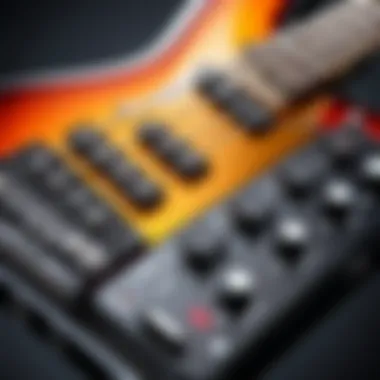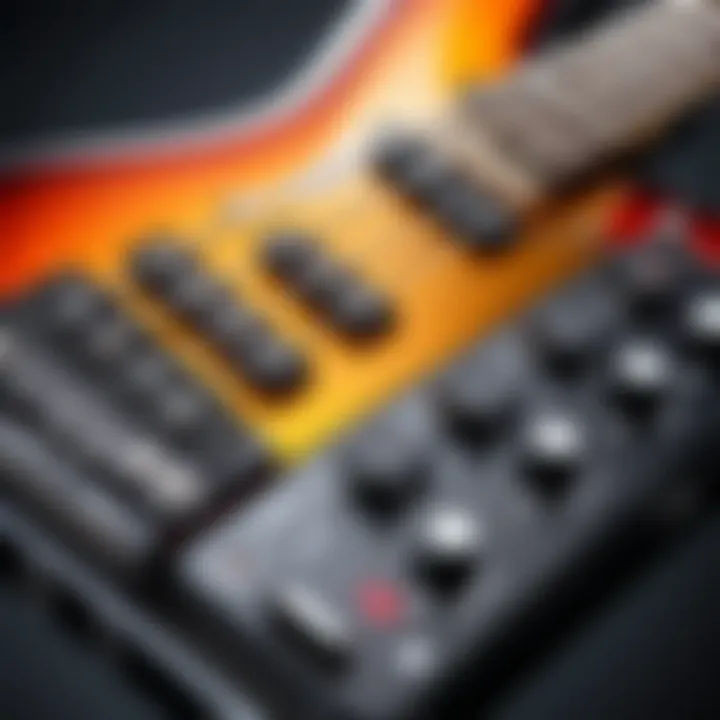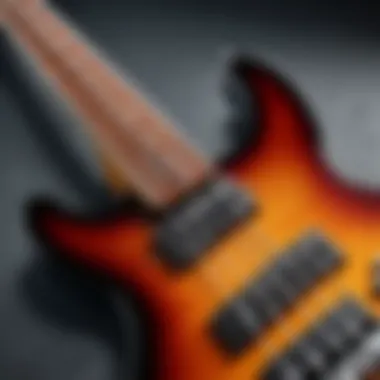Top Free Bass Guitar Apps for Musicians


Intro
In today's digital world, the landscape of music learning and practice has seen a seismic shift. With just a tap or swipe, musicians can access a plethora of resources that were once locked up in hefty textbooks or hidden within the walls of music schools. Among such resources, free bass guitar apps have emerged as indispensable tools for both novice and seasoned bassists alike. Not only do these applications offer a range of features tailored to enhance playing skills, but they also present an exciting avenue for experimentation and creativity. As we explore the various applications available, the focus will lie on their usability and the unique attributes they bring to the table, supporting different learning styles and musical preferences.
To get to the heart of this exploration, it’s essential to understand the technology underpinning these apps. The next section will cover everything from key specifications to the distinctive selling points that make these apps stand out in a crowded marketplace. Whether you're trying to improve your plucking technique or looking to play along with your favorite tracks, there’s a free bass guitar app waiting for you.
Overview of the Technology
In the realm of music applications, it's vital to grasp what technology is being harnessed within these free bass guitar apps. While they each vary in their core functionalities and target audiences, several key elements consistently pop up, enhancing the experience for users.
Key Specifications
- Platform Compatibility: The majority of these apps are engineered for both iOS and Android, thus appealing to a wider audience regardless of device preference.
- Audio Quality: High-definition sound output is becoming standard, allowing users to hear nuances in their playing like never before.
- User Interface Design: Intuitive interfaces are the norm, promoting ease of navigation which is essential for users looking to quickly engage with the app's features.
Unique Selling Points
- Interactive Features: Many apps now come equipped with interactive tools that let users jam with virtual bands, making practice sessions feel less solitary.
- Learning Modules: A plethora of educational elements, including video tutorials and song breakdowns, provide tailored learning experiences.
- Customization Options: Users can adjust settings such as tempo and pitch, ensuring they can practice at a pace that suits their ability.
The proliferation of free bass guitar apps signals a major shift in music education, fostering a democratized approach to learning that any aspiring musician can access.
Design and Build Quality
When it comes to applications,
Preface to Bass Guitar Apps
In today's fast-paced world, the significance of using mobile applications for learning music has surged tremendously. The bass guitar, often considered the backbone of musical ensembles, is no exception. With the growing interest in bass guitar mastery, it's essential to understand how technology can enhance learning experiences. This section delves into the role of bass guitar apps, the core benefits they offer, and what considerations a potential user should keep in mind.
Understanding the Role of Technology in Music Education
Technology has reshaped the landscape of music education, making it more accessible than ever. In the past, aspiring bass guitarists often relied on traditional methods such as books, instructors, or slow video tutorials. But now, with bass guitar apps at the fingertips of learners, the paradigm has shifted.
These apps come packed with features such as video tutorials, interactive lessons, and even real-time feedback on performance. The instant access to valuable resources allows musicians to practice at their own pace, embracing a more personalized learning journey. For example, an app like Yousician not only provides lessons tailored to varying skill levels but also tracks a user’s progress over time, making self-assessment simpler.
Moreover, technology fosters a sense of community among musicians. Through forums integrated into these apps, users can connect, share tips, or even collaborate on music projects. This communal aspect is particularly beneficial for beginners who may feel overwhelmed; knowing that help is just a click away can make a significant difference.
The Emergence of Mobile Applications for Musicians
The mobile app phenomenon has erupted over the last decade, bringing an unprecedented ease of access to musicians of all genres. Now, musicians can carry an entire library of learning tools and resources in their pockets. This shift has particularly favored the bass guitar community, where countless free apps have emerged to cater to various needs.
Many apps have pivoted from traditional learning methods to a more gamified approach, blending learning with play. For instance, apps like Fender Play offer bite-sized lessons that feel more like playing a game than studying. Users get to learn their favorite songs while honing their skills, making the process enjoyable rather than tedious.
App developers have recognized the palette of user needs, creating applications that serve different purposes: tutorials, practice aids, metronomes, and even social networks. Each of these applications serves as a unique tool, designed to support the individual's musical journey. Users now have the ability to choose from a smorgasbord of options, enabling them to find applications that resonate with their particular learning style and preferences.
"The digital age has turned learning the bass guitar from a solitary pursuit into an adventure shared with thousands globally."
As we delve deeper into this topic, it's clear that bass guitar apps are not merely supplementary tools; they are shaping the future of music education, making it more relevant, engaging, and effective.
Criteria for Evaluating Bass Guitar Apps
When it comes to selecting the right bass guitar app, the criteria for evaluation play a fundamental role. With numerous options available, understanding what makes an app stand out can save time and improve the overall learning experience. Not only does a well-chosen app enhance playing skills, but it can also foster a deeper appreciation for music.
User Interface and Experience
The user interface greatly influences how a musician interacts with the app. A clean, intuitive design is vital. Imagine trying to learn a new skill while grappling with a confusing layout; it dampens motivation faster than a leaky faucet. Therefore, apps that prioritize simplicity in navigation and offer a visually appealing interface tend to be more popular. These factors contribute to an overall enjoyable experience, enabling users to focus on mastering their instrument rather than wrestling with the app itself.
Features and Functionality
Features and functionality are the meat and potatoes of any app. In this regard, let's break down three critical aspects:


Learning Tools
Learning tools are the backbone of educational apps, fostering a hands-on approach that many learners crave. Many of these apps integrate unique instructional methods, including interactive lessons designed for various skill levels. A standout characteristic of learning tools is their adaptability; they can tailor content based on a user’s progression.
For instance, if an app employs gamified elements, players are more likely to engage and find enjoyment in practice sessions. However, there is a trade-off—while gamified learning can enhance motivation, it may sometimes favor entertainment over rigorous instruction. Therefore, understanding an app's approach to learning tools is key.
Practice Modes
Practice modes are essential for applying skills in real-time. These modes allow users to practice scales, songs, or techniques at various speeds, and often include options to loop sections for repeated practice. A crucial aspect of practice modes is their ability to adjust difficulty levels, catering to both novices and seasoned players.
Some apps also provide backing tracks, which can make practice sessions feel more dynamic. However, certain apps may not offer extensive content, leading to a lack of variety. The richness of practice modes can ultimately determine whether a user abandons an app or keeps it in rotation.
Tuning Systems
Tuning is a fundamental aspect of playing bass guitar. Apps that incorporate advanced tuning systems can be particularly beneficial. Many modern applications provide various tuning options, including standard and alternative tunings, in a user-friendly format. This allows musicians to quickly find the right sound without wasting precious time.
A unique feature in some apps is the ability to visualize the string vibrations, giving players a more engaging tuning experience. Nevertheless, while some might laud the advanced features, others may find such systems overly complicated, especially if they're not well-explained.
Community and Support Resources
Having access to a supportive community can elevate the learning experience. Apps that offer forums or user groups create an environment where musicians can exchange tips, ask for feedback, and build connections. Furthermore, having a solid support system, such as responsive customer service, can significantly mitigate frustrations encountered during the learning process.
With the various criteria laid out, one can approach the world of bass guitar apps with a clearer perspective. Considering user interface, features, and community support will not only streamline the selection process but also enrich one’s musical journey.
Top Free Bass Guitar Apps
In the realm of music learning, bass guitar apps have opened a whole new dimension of possibilities, drawing in players from all walks of life. These digital tools are crucial for those seeking to enhance their skills, catering to both newbies and seasoned musicians. It’s not just about learning to strum; it’s also about the accessibility and convenience these applications provide. Not to mention, they’re mostly free, making them financially appealing for budding talents. With tailored approaches to practice and learning, players can find a rhythm that fits their style and goals.
Overview of Popular Applications
Several applications have gained traction among bass enthusiasts. Some of the standout options include Yousician, Ultimate Guitar, and Fender Play. Each of these offers unique functionalities, from instructional videos to vast libraries of songs. As players navigate through these applications, they discover tailored options that cater to their individual tuning preferences, learning speeds, and even styles—be it rock, jazz, or blues. This engagement with popular applications sparks conversation and camaraderie among users, as they are often excited to share their progress and favorite resources within their musical communities.
App Features Breakdown
When delving into the functionality of these bass guitar applications, three key elements stand out: audio quality, library of songs, and learning progress tracking. Each feature distinctly contributes towards making the learning process more effective and enjoyable.
Audio Quality
The audio quality in bass guitar apps is a fundamental aspect that often gets overlooked. A crisp and clear sound can make a world of difference when practicing. It allows players to hear the nuances in their performance better, which aids in developing an ear for music. An app that boasts high fidelity audio will typically include features like reverb and tone adjustments, enhancing overall sound reproduction. For instance, apps like Yousician are known for their robust audio engine, providing immersive soundscapes that mimic a real-life playing environment.
This superiority in audio quality not only aids beginners in understanding how their notes should sound but also keeps experienced players engaged and motivated by providing a more realistic playing experience.
Library of Songs
The library of songs within these apps serves as a treasure trove for learning. A rich selection of tracks can significantly impact how effectively a user improves. It's not simply about quantity; the quality and variety of songs are equally important. Many popular apps allow users to play along with well-known songs, creating an engaging way to practice. For instance, Ultimate Guitar provides an extensive database ranging from classic hits to contemporary chart-toppers.
What sets a good song library apart is the inclusion of lesson modes where beginners can start slow, gradually increasing the tempo. Such features help users build confidence and rhythmic capability without feeling overwhelmed.
Learning Progress Tracking
Learning progress tracking is another essential facet that has gained traction in bass guitar apps. Being able to see a clear outline of one’s progress can be incredibly motivating. Features that allow users to log their practice sessions, set specific goals, and track improvements over time create a structured framework that encourages consistent practice.
For example, Fender Play includes a dashboard that showcases users' achievements and milestones, keeping them engaged and on track. This element is particularly helpful for setting targets and holding oneself accountable in a self-directed learning environment.
In summary, the top free bass guitar apps offer a multitude of features that not only enhance the learning experience but also contribute to an engaging and immersive musical journey. The variety they provide ensures that players can explore their passions while improving their skills effectively.
Learning with Free Bass Guitar Apps
In today's digital age, learning plays a pivotal role, especially for aspiring bass guitarists. Free bass guitar apps have emerged as effective tools, facilitating self-teaching and structured progress tracking. The vastness of resources available online can sometimes seem overwhelming; however, these apps simplify learning by providing tailored experiences suited for individual needs. For tech-savvy musicians who are eager to advance their skills, these applications not only make learning accessible but also engaging.


How Apps Facilitate Self-Teaching
Self-teaching can often feel like steering a ship without a compass. Yet, bass guitar apps act as a guide, helping students navigate their learning journeys with ease.
Video Tutorials
Video tutorials have become a staple in modern learning, delivering information in a visually appealing manner. These videos often cover a range of topics, from fundamental techniques to intricate riffs. The key characteristic of video tutorials is their ability to demonstrate concepts in real time, allowing learners to visually grasp what they're hearing. This beneficial choice resonates among users particularly because it aligns with the rise of visual learning in education.
The unique feature of video tutorials lies in their adaptability. Users can pause, rewind, or replay sections to catch nuances that might have initially slipped by. This flexibility creates an environment where users can learn at their own pace, which is an advantage for beginners who may need extra time grasping certain concepts. However, the downside can be that not all tutorials are created equal; some may lack depth or clear explanations, potentially leaving learners in the lurch.
Interactive Lessons
Interactive lessons bring a new dimension to learning, making the process not just educational but also fun. The distinct advantage of interactive lessons lies in their ability to engage users actively—think of it as practicing with a virtual band that guides you through every note. This engages the user while encouraging them to identify mistakes and correct them on the fly, a key element in mastering the bass guitar.
One notable unique feature of interactive lessons is instant feedback. Many applications offer real-time insights and suggestions, tailoring the learning experience to fit the playing level of the user. The appeal of interactive lessons stems from their immersive nature, which keeps users motivated. However, on the flip side, the effectiveness heavily relies on the sophistication of the app; some less advanced platforms may not provide the continuity or detail needed to make substantial progress.
Structured Learning Paths
Moving away from a haphazard approach to learning, structured learning paths within bass guitar apps provide roadmaps to mastery. These paths guide users through progressively complex levels of skill development. Each staged step prepares learners for the next, making the process less overwhelming.
When learners can visualize their progress and goals, they’re more likely to stay committed. Structured paths often incorporate various learning elements, integrating video lessons, quizzes, and practice sessions. This organized style addresses the diverse needs of learners by catering to multiple preferences, whether they are auditory, visual, or kinesthetic.
In essence, embracing free bass guitar apps can lay a solid foundation for both beginners and seasoned players. By blending technology with traditional music education techniques, these tools foster environments that enhance learning and personal growth.
Comparisons and User Reviews
When delving into the vast world of free bass guitar apps, understanding user experiences is crucial. Evaluating user reviews lets potential users see firsthand the real-world performance of these apps. This not only aids in making informed decisions but also highlights the strengths and weaknesses of individual applications. Moreover, comparisons enable users to weigh their options based on practical insights rather than just promotional materials.
Feedback from Bass Guitarists
User feedback comes from a wide array of bass guitarists, from novices to seasoned players. Many emphasize the importance of ease of use and accessibility. For instance, one user might praise an app for its intuitive layout, making navigation seamless even for beginners. Another may note the variety of learning tools available, such as video tutorials or practice exercises, which align with their specific learning styles.
Consistent themes often emerge in reviews:
- App Performance: Many reviews delve into how the app functions. Freezing or lagging can be deal-breakers, especially during practice.
- Song Library: Users frequently rate an app based on the breadth and depth of its song catalog. Those looking to play along with their favorite tracks often seek apps that offer extensive libraries.
- Community Support: Users value apps that foster a sense of community, providing forums or chat functions. Positive interactions within these spaces can enhance motivation and learning.
Comparative Analysis of Leading Apps
In looking at various applications, it becomes evident that each has its distinct flavor. A comparative analysis reveals crucial elements that make one app more desirable based on personal needs and preferences.
Pros and Cons
Understanding the pros and cons of each application is fundamental. For instance, one app may be praised for its comprehensive learning pathway, attracting those who prefer structured lessons. However, it might have fewer songs available, which could deter those primarily interested in playing along with music.
The standout feature often lies in the balance between functionality and user engagement. Many users appreciate apps that don’t just offer a plethora of tools but actually engage users in their learning journey. Notably, free apps that provide regular updates often see higher user satisfaction, as they continually adapt to user needs.
Value for Money
While many of the focus on these apps is on free access, the concept of value for money extends to how much users perceive they're gaining. For example, if a free app offers premium features that enhance the overall experience, users may consider that exceptional value, even if they later choose to upgrade or make purchases.
Key considerations here include:
- Quality of Features: Some apps provide extensive tools while others may be flatter in terms of offerings. Users often weigh which tools best cater to their learning style.
- Cost of Premium Versions: If a free app presents an overly invasive push to upgrade, it may put off some users.
Ultimately, feedback and comparisons not only inform individual choices about which app to download but also paint a broader picture of trends and shifts within the realm of bass guitar education, making it essential for both novices and veterans alike.
Integration of Apps into a Daily Practice Routine
In today’s fast-paced digital world, integrating applications into daily practice routines has become a no-brainer for the modern bass guitarist. These apps not only enhance the overall practice experience but also assist in transforming practice from a mundane activity into an engaging journey of musical growth. By tapping into technology, players can customize their routines, setting their sights on attainable goals while having fun along the way.


Using bass guitar apps, musicians can seamlessly incorporate various features geared toward making practice more effective. This is particularly beneficial for those just starting and even for seasoned players looking to refine their skills. Whether it’s a beginner trying to keep the metronome steady or a pro working on complex grooves, these apps provide a treasure trove of tools designed to aid in music mastery.
Moreover, technology helps track progress over time, giving musicians a visual representation of their enhancements. The satisfaction of seeing tangible results encourages consistent practice, keeping players motivated and eager to improve. Here’s a closer look at how these apps can lay the groundwork for a more productive practice schedule.
Setting Goals with App Features
Setting clear and attainable goals is fundamental when it comes to practice. Most bass guitar apps come with features that allow users to set specific objectives—whether it's mastering a new song, improving technique, or simply increasing playtime. For instance, an app may enable the creation of a structured weekly practice schedule, thereby enforcing accountability.
Consider using features such as:
- Progress Tracking: Some apps have a way of logging daily sessions, so that you can easily measure your growth.
- Skill Challenges: Fun challenges push your boundaries and keep the boredom at bay.
- Learning Modules: Different apps offer various skills to focus on, from finger exercises to timing drills. Choose one and make it your mission for the week.
Through the assistance of these tools, players can consciously direct their practice instead of wandering aimlessly. This structured approach not only streamlines learning but also enhances motivation and satisfaction.
Incorporating Technology in Traditional Practice
While it's easy to think of a bass guitar app as a replacement for traditional practice, it’s more of an enhancement. Balancing technology with fundamental techniques fosters a musicality that runs deep. For example, using an app to learn a particular song can supplement traditional methods like reading sheet music or ear training.
You might consider:
- Alternative Tuning: Some apps come equipped with tuning features that allow bassists to experiment with alternative tunings, expanding musical versatility without losing traditional skills.
- Jam Tracks: Incorporating jam tracks from an app to play alongside can bridge the gap between solitary practice and real-world performance scenarios.
- Video Lessons: Watching tutorials can augment traditional practice. You can see finger placement, posture, and technique—elements that are often missed when learning from just audio.
By harmonizing the best of both worlds—apps and traditional techniques—players can cultivate a richer, more well-rounded musicality. It’s about finding a rhythm that fits one’s personal learning style, making the hours spent with an instrument even more rewarding.
"Technology can provide invaluable resources, but at the heart of mastering an instrument lies consistent practice, creativity, and love for the craft."
As apps continue to evolve, discovering how they can blend seamlessly into practice routines is a journey worth undertaking. Embracing these solutions not only paves paths for improvement but also cultivates a deeper connection to music itself.
Future of Bass Guitar Apps
The realm of bass guitar apps is continually evolving, reshaping the way musisians learn and interact with music. This section delves into the future of these applications, considering how they might further enhance the learning experience and playing capabilities. As technology advances, so do the possibilities for bass guitar enthusiasts, making it essential to keep an eye on these developments.
Trends in Music Technology
In the last few years, the landscape of music tech has seen significant shifts. For one, there’s a growing trend towards Artificial Intelligence in music applications. Imagine an app that can actually analyze your playing and offer real-time feedback tailored just for you. This capability isn't science fiction anymore; developers are already working on AI algorithms that's capable of assessing your technique and suggesting improvements.
Additionally, virtual reality (VR) and augmented reality (AR) are also starting to make their way into music education. Picture this: you put on a VR headset and find yourself in a virtual jam session, playing alongside legendary bass guitarists. This immersive experience can create a unique learning environment that makes practicing feel less like a chore and more like an exciting adventure.
Moreover, the rise of subscription models for app features is changing how users access music education. Instead of one-time purchases, many apps are shifting to a subscription model, enabling ongoing access to a wealth of resources and updates. This approach provides not only fresh material but also ensures that the technology keeps pace with user needs.
Potential Developments in App Features
As we gaze into the crystal ball of future app designs, several potential developments come to mind that could significantly enhance user experience:
- Cloud Integration: Users can store their progress and settings on the cloud. This makes it simple to shift from one device to another without losing your place, or your hard-earned progress.
- Enhanced Social Features: Imagine being able to collaborate or jam online with fellow bassists, regardless of distance. Apps could integrate real-time collaboration tools, making it a breeze to engage with others, share tips, and learn collectively.
- Customizable Learning Paths: Not every player learns the same way. Future apps might allow users to create personalized learning paths based on their unique musical interests and strengths. This tailored experience could revolutionize how individuals approach learning the bass guitar.
- Gamification: By incorporating game-like elements, such as challenges or badges for milestones, learning can become more engaging. Think of it as leveling up in a video game – every small achievement can add to the motivation to improve.
In summary, the future of bass guitar apps is bursting with potential. By harnessing trends like AI, VR, and cloud technology, developers may pave the way for incredibly immersive and effective learning experiences. Additionally, enhanced social and customizable features can ensure that players continue to grow in their craft, elevating both individual skills and the broader music community.
Finale
In today's music landscape, understanding the role of free bass guitar apps is essential for both novices and seasoned players alike. These applications offer an array of features that not only enhance the learning process but also ensure that practice time is productive and engaging. Acknowledging the unique elements these apps provide can unlock a pathway to musical proficiency that may have seemed distant without such tools.
Key Takeaways on Utilizing Free Bass Guitar Apps
- Accessibility: Many free apps eliminate barriers to entry in learning the bass guitar. By providing a wealth of resources at no cost, they cater to individuals who may otherwise find it difficult to access formal instruction.
- Tailored Learning Experience: Users often find that the interactive lessons, video tutorials, and customizable practice modes allow them to learn at their own pace. Each player’s journey becomes more personalized, which is particularly valuable in a field as subjective as music.
- Enhanced Community Support: Numerous apps host vibrant user communities where bassists at different levels can engage. This peer interaction leads to valuable feedback and support, fostering a sense of belonging among learners.
In combining these advantages, free bass guitar applications become crucial tools in the development of musical skills. Players are encouraged to explore various apps to discover which features resonate with their learning styles, allowing for an effective and enjoyable practice experience.
Final Thoughts on the Evolving Landscape of Music Learning
As technology continues to advance, the potential for innovative features within music apps expands. The integration of augmented reality for virtual lessons or artificial intelligence to personalize learning experiences may well define the next generation of musical education.
Beyond mere convenience, these advancements in bass guitar apps could lead to more inclusive and diverse musical expressions. Musicians can collaborate across borders and cultures, blending styles which were never before possible. It’s a marvel to consider how the very nature of music learning is shifting, thanks to such readily available digital tools.
To sum it up, free bass guitar applications represent not just a trend but a shift in how musicians interact with learning. They empower players and redefine traditional methods of practice and education. Embracing these changes means not just keeping up with current trends but participating in a broader conversation about the future of music.







